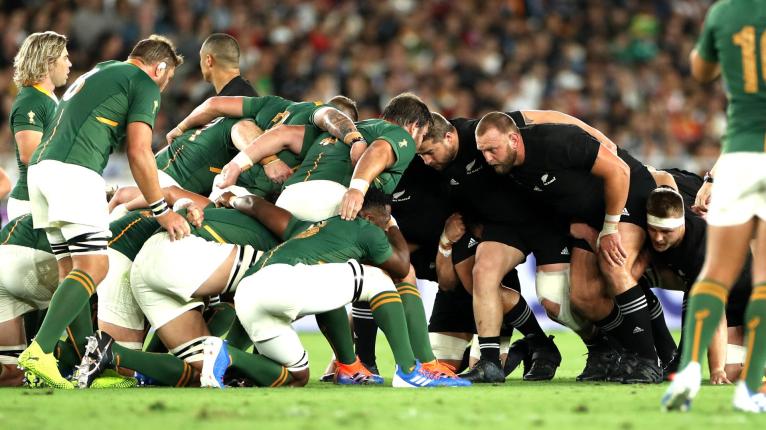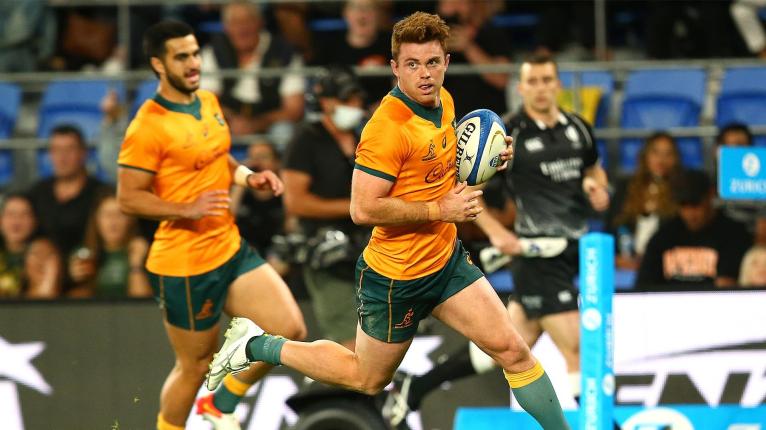It ended up being a relatively crazy Rugby Championship. The All Blacks won their seventh title, probably looked the most complete – certainly the most balanced – team and yet somehow we reached the end with the Springboks still at world number one in the rankings and the team everyone will see, with two years still go, as favourites to defend their World Cup in 2023.
And let’s not forget the Wallabies in all this, who may have opened the tournament with two successive defeats to the All Blacks, but who finished it with four consecutive wins, enabling them to jump to third in the world rankings and look decidedly like a team with plenty more to come.
The evidence presented in the 2021 Rugby Championship provides a relatively strong basis to peer into the future to work out what might happen at the 2023 World Cup.
Certainly, the All Blacks are of that view, believing that in particular, their two tests against the Springboks have provided a strong and invaluable gauge to assess their current strengths and weaknesses.
They are not pinning their entire future road map on what happened in their two tests against South Africa this year, but they are realistic enough to know that the Boks asked questions of them that none of Tonga, Fiji, Australia or Argentina did.

It’s all well and good running riot against those sides as the All Blacks did, but it was something of a false sense of security to believe that posting big wins in those tests made everything right in New Zealand’s world.
Those games provided a basis to see that the All Blacks are a vastly improved team than the one they were in 2020 and have developed a stronger understanding of each other and how they want to play.
Those games also showed that the All Blacks are building quite the depth of talent, with strong performances coming from new boys Ethan Blackadder, Luke Jacobsen and Samisoni Taukei’aho, while the likes of Akira Ioane, David Havili, Will Jordan, Sevu Reece and Jordie Barrett embedded themselves in test football.
The return of Brodie Retallick and Beauden Barrett enhanced the sense the All Blacks were building and then there was the form of Rieko Ioane and Aaron Smith – these two were providing the magic and coming into the last two Tests of the Rugby Championship, the All Blacks felt they were tracking just how they wanted.
What we discovered, however, is that there are some major areas for them to fix – starting with the set-piece, as the Boks exposed the All Blacks at lineout and scrum.
The All Blacks need Sam Whitelock back at lock to restore the lineout and provide his grunt to the engine room and they need to develop one of their loose forwards – most likely Akira Ioane – into a better lineout jumper.
The curious thing being that the All Blacks knew that’s where the Boks would come at them. They knew that was an area of their game they had to get right and they believed, based on how they had performed against the Pumas and Wallabies, they were ready.
It turned out they weren’t. The lineout fell apart in the first test and then, strangely for the All Blacks, fell apart again in the second. The whole All Blacks legend is built on their ability to fix things quickly.
The scrum was okay for 50 minutes in both tests but once Joe Moody and Nepo Laulala went off, it creaked and moaned to an alarming degree. In the second test, the last two scrums were catastrophically bad.
The All Blacks need Sam Whitelock back at lock to restore the lineout and provide his grunt to the engine room and they need to develop one of their loose forwards – most likely Akira Ioane – into a better lineout jumper.
And so too do they know now that they have to work on the scrummaging of all of their props, especially, Ofa Tuungafasi and George Bower.

As head coach Ian Foster said after the 31-29 loss on the Gold Coast: “We muddled around a little bit.
“They came at us with their set-piece and we hung tough but in that last quarter we struggled to play with the ball in their half. That was the area I thought we got frustrated and didn’t have quite the direction we needed to so we’ll go and have a look at that.”
That failure to compete at set-piece was intrinsically linked to the other problems the All Blacks had. They couldn’t dominate the collision or tackled ball because they weren’t coming from a strong platform and that limited their attacking options and variations.
“We’re probably not where we want to be in terms of our game and how we want to play. Africa showed that and put us under pressure,” said stand-in captain Ardie Savea. “The biggest learning is working on the areas we need to and moving forward.”
We approached these last two tests as a chance to test ourselves against a foe that we know plays a style that can suffocate you and we got some good lessons out of that.
All Blacks coach Ian Foster on the two-match series with the Springboks.
Maybe it’s fair to believe that if they fix their set-piece they will fix most of the other parts of their game, too, and with Whitelock, Dane Coles and Sam Cane all to return, as well as the quite brilliant Aaron Smith at halfback, the All Blacks should be confident they can make the gains they need.
They should also be confident that they have to some degree already developed the sort of indefatigable spirit that defines the best teams. They were second best in virtually every facet in the second half of the Gold Coast Test and yet they hung in there to twice claw their way back into a lead they scarcely deserved.
That’s also what they did in the first test and it says something to be able to be dominated the way they were and yet win one test and be just 30 seconds and one poor technical act away from winning the second.
“We’ve got a tight group that’s excited about growing,” says Foster. “We approached these last two tests as a chance to test ourselves against a foe that we know plays a style that can suffocate you and we got some good lessons out of that. We showed we can deal with that, but we also showed we need to deal with it for longer periods.”
The challenge for the All Blacks in the next 18 months or so is to absorb every lesson they can from every team they play. They have been underexposed to bruising, set-piece teams as a result of Covid and they need to continue to build the skills and experience to be able to adapt their game to cope with the powerful, slower rugby favoured by the Boks, England, Ireland and Wales.

That’s still the key for them – to build the solidity and physicality in their game to be able to continue to attack wide. When Ioane is able to get into space he’s deadly and the All Blacks remain the masters at taking a mile if they are given an inch – easily the most clinical and inventive attacking team on the planet.
They just need to be more consistent and more adept at finding ways to ensure their skill-sets can flourish in the face of muscular, defensive opposition.
For the Boks, the question is how much can they continue to grow their pass and catch and marry it with their kick-chase, driving maul approach?
They were tough to beat in Townsville, but a far better team again in the Gold Coast when they balanced their traditional strengths with more ball in hand work.
When they mixed things up, they had the All Blacks in serious trouble and they were a different team almost when they kicked and ran as opposed to just kicking.
There’s improvement but I think we’re creating some belief around how we want to play and what Wallaby rugby looks like.
Wallabies captain Michael Hooper
When they get Pieter-Steph du Toit and Cheslin Kolbe back from injury, they will be at another level again and while the All Blacks have plenty of upside still to find, so too do the Boks and based on what we have seen in 2021, they will most likely go into the next World Cup as the team to beat.
The Southern Hemisphere dark horse is Australia, who seem to finally have learned how to scrum and win their share of lineout ball which has transformed them.
They have long been a street-wise team at the tackled ball area and clever in how they move the ball to space, but now they are playing their ruck and run game with the foundation that comes with a strong set-piece.
“We’re sticking to the script, mostly,” said captain Michael Hooper after their fourth successive win.
“There’s improvement but I think we’re creating some belief around how we want to play and what Wallaby rugby looks like.”

His last point is the most important. The Wallabies now have a defined style and are playing the game at a pace few teams can live with.
They are also now able to select from their legion of offshore defectors and with Samu Kerevi back in their midfield and Andrew Kellaway proving the back three find of the tournament, not to mention the resurrection of Quade Cooper, the Wallabies are starting to look like a serious contender.
They have depth where they need it, two superb halfbacks, one of the world’s best wings in Marika Koroibete and in Michael Hooper, a truly inspirational skipper.
Two years out from the World Cup and all three of South Africa, New Zealand and Australia will say they are content with how they are placed and how they are building.
They have finished the Rugby Championship as respectively one, two and three in the world, yet with a sense they each have plenty more to come.


Comments
Join free and tell us what you really think!
Sign up for free